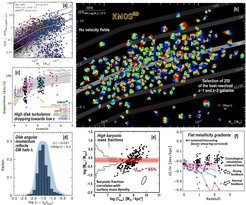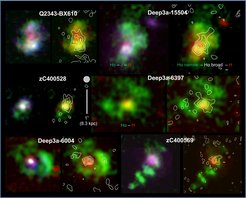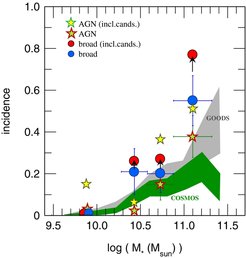News and Recent Results of the MPE Infrared/Submillimeter Group
KMOS3D Survey of Spatially Resolved Gas Kinematics, Star Formation, and ISM Properties Sheds New Light on the Physics of Galaxy Evolution
June 2016
Our comprehensive and highly successful multi-year KMOS3D survey takes advantage of the efficient multiplexing of the new near-IR 24-IFU KMOS instrument at the Very Large Telescope to spatially resolve the ionized gas kinematics, star formation, outflows, excitation, and metallicities of a large and homogeneous sample of z ~ 0.7−2.7 mass-selected galaxies. KMOS3D is a 75-night Guaranteed Time Program started in November 2013 and led by the MPE Infrared/Submillimeter Group and MPE/OPINAS and USM. After 2.5 years and 52 nights of productive observing campaigns, the sample has now reached 564 galaxies, with an overall Hα detection fraction of 80% (and as high as 90% for main-sequence star-forming galaxies). The survey was carried out in well-studied extragalactic fields, benefitting from extensive multiwavelength data that include the far-IR Herschel PEP survey and high-resolution near-IR/optical grism and imaging data from the 3D-HST/CANDELS HST Treasury programs. KMOS3D is designed to provide an unbiased census from deep integrations (~ 5 to 25 hours) of the Hα+[NII]+[SII] line emission resolved on seeing-limited scales of 4 to 5 kiloparsecs, over a wide range of galaxy parameters and five billion years of cosmic time. The strategy is uniquely enabling faint-line emission mapping in individual objects and pushing near-IR IFU studies into new regimes, such as lower-mass star-forming galaxies and high-mass submain-sequence galaxies in the process of quenching. The ighlights of our results are shown in the figure below. They robustly confirm the earlier findings from our SINS/zC-SINF near-IR IFU survey with SINFONI on the majority of disks among high-z star-forming galaxies and their elevated gas turbulence compared to present-day spirals, and on the ubiquity and origin of powerful AGN- and star-formation-driven gas outflows. They also provide new constraints on the angular momenta, baryonic mass fractions, outer disk structure, the relation between mass, metallicity, and star formation, and gas phase O/H abundance gradients. Furthermore, our results shed new light on dense core formation and star formation quenching in high-mass galaxies.

More information:
- Research paper: Wisnioski et al. 2015, ApJ, 799, 209
- Research paper: Burkert et al. 2016, ApJ, 826, 214
- Research paper: Wuyts et al. 2016, ApJ, 831, 149
- Research paper: Wuyts et al. 2016, ApJ, 827, 74
ALMA Reveals Planetary Construction Sites
December 2015

By using the Atacama Large Millimeter/submillimeter Array (ALMA), we have discovered the clearest indications yet that planets with masses several times that of Jupiter have recently formed in the discs around young stars. New images of transitional discs show that there are significant amounts of gas within the dust gaps, and that the gas also possessed a gap, which was up to three times smaller than that of dust. This can only be explained by a scenario in which newly formed massive planets clear the gas as they travel around their orbits, but trap the dust particles further out. The data rule out other scenarios for the observed set of discs.
More information: ESO press release
Evidence for Widespread AGN-Driven Outflows in the Most Massive z ~ 1–2 Star-Forming Galaxies
November 2014


This figure shows the incidence of AGN in massive z ~ 1–2 star-forming galaxies. All indicators suggest a rise with stellar mass, but the incidence of AGN-driven outflows (blue and red filled circles) is larger than traditional X-ray/optical/IR evidence for AGN in the same galaxies (stars) or similar evidence in large samples in well-studied extragalactic deep fields (shaded bands).
Very deep laser guide star-assisted adaptive-optics observations allowed us to detect ubiquitous powerful nuclear outflows in massive (1011 M☉) z ∼ 2 star-forming galaxies, which are plausibly driven by an active galactic nucleus (AGN). The spectra in their central regions exhibit a broad component in Hα and forbidden [NII] and [SII] line emission, with typical velocity FWHM ∼ 1,500 km s-1, high [NII]/Hα ratio ~ 0.6, and intrinsic extent of 2 to 3 kiloparsecs. At larger radii, weaker and less wide broad components suggest star-formation-driven outflows. The high inferred nuclear mass outflow rates and frequent occurrence suggest that the nuclear outflows efficiently expel gas out of the centers of the galaxies with high-duty cycles, and may thus contribute to the process of star formation quenching in massive galaxies. Extending to a large sample observed without adaptive optics, we find that the incidence of the most massive galaxies with broad nuclear components is at least as large as that of AGNs identified by X-ray, optical, infrared, or radio indicators, as expected for rapidly varying AGN whose outflows are visible with larger-duty cycle than X-ray or optical continuum. The mass loading of the nuclear outflows is near unity. Our findings provide compelling evidence for powerful, high-duty-cycle, AGN-driven outflows near the Schechter mass, that act across the peak of cosmic galaxy formation.
More information:
- Research paper: Förster Schreiber et al. 2014, ApJ 787, 38
- Research paper: Genzel et al. 2014, ApJ 796, 7



